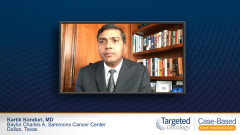
Lurbinectedin in the Treatment of Small Cell Lung Cancer
Kartik Konduri, MD, describes the phase 2 basket trial of lurbinectedin in the treatment of extensive-stage small cell lung cancer.
Kartik Konduri, MD: The Trigo et al trial that utilized lurbinectedin was a single-arm phase 2 study which incorporated 9 tumor subtypes. The trial encompassed 105 patients with small cell lung cancer, and this publication pertains to those patients. The trial was conducted between 2015 to 2019, and the median duration of follow-up was approximately 17 months.
In these 105 patients, the inclusion and exclusion criteria were to particularly involve patients who have progressed after at least frontline therapy. All patients had previously been exposed to platinum-based compounds. Patients who had CNS [central nervous system] metastases were excluded in this particular trial. The trial evaluated a primary endpoint for outcome was overall response rate. Other endpoints that were evaluated included duration of response, progression-free survival [PFS], as well as overall survival [OS]. Small post hoc analysis for immunotherapy-based patients and the outcomes was also evaluated.
This trial utilized lurbinectedin at 3.2 mg2 every 3 weekly basis given IV [intravenous]. It incorporated possibilities of dose interruptions and dose delays, and although primary prophylaxis with G-CSF [granulocyte colony-stimulating factor] was not allowed, secondary prophylaxis was allowed in this trial. Thirty percent of the patients in this trial had limited-stage small cell lung cancer on initial diagnosis. Whereas 70% had extensive-stage disease. Approximately 60% of these patients had previously had prophylactic cranial irradiation. Performance status of ECOG [Eastern Cooperative Oncology Group] 0, 1, or 2 were allowed, although only a small proportion of patients were ECOG 2.
A prespecified subgroup analysis of patients with chemotherapy-free intervals less than 90 days and greater than 90 days was incorporated in the study evaluation. After a median follow-up of 17 months, the response rates in this trial were 35%. In the population of patients who had a chemotherapy-free interval of less than 90 days, the response rates were about 22%, with a median PFS of 2.5 months and a median OS of roughly 5 months. For those patients who had a chemotherapy-free interval of greater than 90 days, the median PFS was 4.5 months, the median OS was 11.9 months, and the response rates were 45%.
There was an updated analysis for a small proportion of 20 patients who had a prolonged chemotherapy-free interval of more than 180 days, and, in those patients, the median OS was 16.2 months with a response rate of 60%. In a small proportion of patients who received immunotherapy, about 60% of them had a durable response. Regarding the adverse events in this trial, many patients had abnormalities in the labs, including elevations in creatinine and presence of higher transaminases and liver toxicities. These were generally grade 1 and grade 2. Five percent of patients had grade 3 and beyond neutropenia, and 5% of patients had febrile neutropenia in this trial.
In general, it was felt that the trial study medicine was well tolerated. Overall, it suggests that this medicine is an active compound in the particular space of second-line small cell lung cancer patients. However, the caveat for this trial includes the fact that it was a single-arm phase 2 study. Although it included 105 patients, these were incorporated from a basket trial and also it is important to note that the patients did not have brain metastases when they entered into this trial.
In the past, there have been combinations of lurbinectedin with doxorubicin in a phase 1 setting which has suggested its significant improvement in response and, based upon that, a confirmatory phase 3 trial called ATLANTIS was conducted. This trial used a lower dose of lurbinectedin than what was used in the basket trial.
The lurbinectedin medicine was combined with doxorubicin and was compared with CAV [cyclophosphamide, adriamycin and vincristine] or topotecan for its outcomes. The primary outcome for this trial was OS, and we recently learned in a press release that the outcome for OS was not met. However, secondary endpoints including perhaps PFS was supposedly significant. We do not know all the data from this trial and, therefore, we keenly await presentation in future meetings to learn more about its efficacy.
Transcript edited for clarity.
Case: A 68-Year-Old Woman with Extensive-Stage Small-Cell Lung Cancer
Initial Presentation
- A 68-year-old woman presented with fatigue and a cough
- PMH/PSH: hysterectomy at age 55
- SH: 55-pack year smoking history
- PE: decreased breath sounds in the left lung, cervical lymph node enlargement
Clinical Workup
- Labs: WNL
- Lymph node biopsy showed small cell carcinoma
- Chest/abdomen/pelvic CT showed a 7.4 cm mass above the diaphragm, a small contralateral lung nodule and evidence of invasion into the left side of the pericardium
- PET scan showed activity in both lungs, above the diaphragm with small hypermetabolic activity in the surrounding area
- Contrast‐enhanced MRI of the head was negative for brain metastases
- Stage IV extensive-stage small-cell lung cancer; ECOG PS 0
Treatment
- Initiated carboplatin + etoposide + atezolizumab for 4 cycles; followed with atezolizumab as maintenance therapy
- Repeat CT scan showed a suspicious hepatic mass
- Initiated lurbinectedin 3.2 mg/m2 IV q21 Days









































